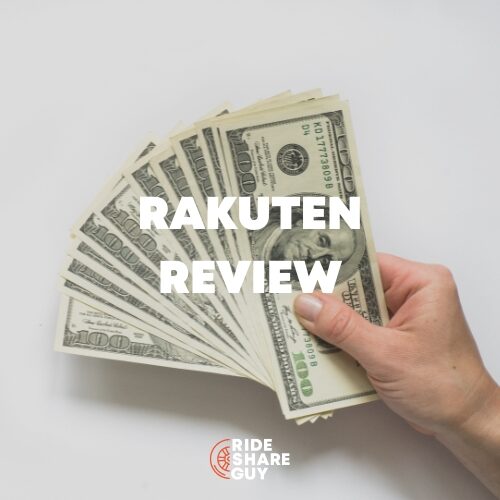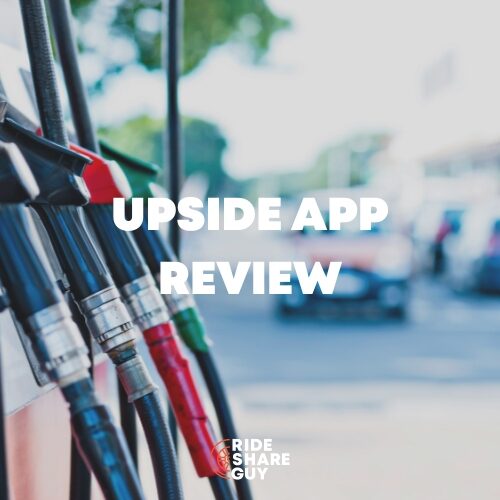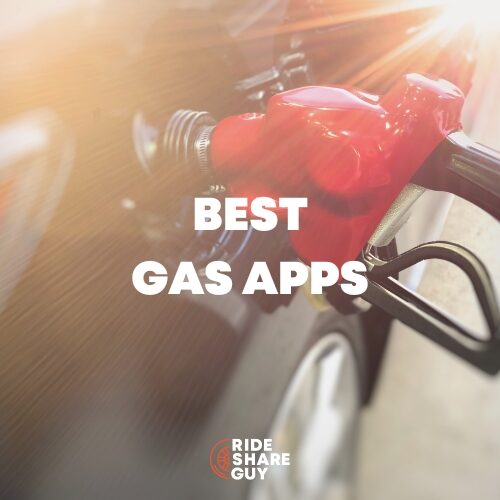Knowing how to save money on gas is one of the most important tips I can share as an Uber driver. While car maintenance and repairs are hefty costs, gas is a regular and ongoing cost that can quickly eat your profits.
Here are my favorite ways to save money on gas.
14 Realistic Ways To Save Money on Gas
Unfortunately, there isn’t one single way to save money on gas. It’s best to use multiple methods to reduce your rideshare driving costs.
Check out the 14 ways to save money on gas below and see how many you can use to keep your costs down and profits up.
- Pay Cash
- Use a Gas Rebate App
- Use a Gas Rewards Program or Cash Back Credit Card
- Check for Grocery Store and Gas Station Partnerships
- Watch for the Cheapest Days of the Week To Fill Up
- Try Gas Apps To Find the Cheapest Gas Prices
- Maintain Your Speed
- Limit Idling
- Avoid Hard Braking and Rapid Acceleration
- Use AC Wisely
- Plan Your Route to Avoid Traffic
- Maintain Good Tire Pressure
- Maintain Your Engine
- Watch Your Car’s Performance
How To Save Money on Gas at the Pump
Obviously, the easiest place to save money on gas is at the pump. Knowing how to pay, when to fill up, and how to find the cheapest gas will help you save money on gas.
1. Pay Cash
Looking closely at most gas station pricing advertisements, you’ll see they have a cash and a credit card price. The cash price is always lower because it saves gas stations the surcharge credit card companies charge to accept credit card payments. Depending on the gas station, you may save 5 to 10 cents per gallon.
Yes, paying inside is more of a hassle, but saving a dollar or two on your gas each time you fill up can add up fast.
2. Use a Gas Rebate App
A gas rebate app, like Upside, pays you to fill your tank.
Download the Upside app and activate an offer to earn cash back before filling your gas tank. You can link the card you use to pay for gas for automatic cash back or upload your receipt after filling up to earn money back.
GasBuddy is another way to get cash back, but instead of getting cash back on gas, you earn ‘gas back’ by shopping at their partner retailers. You’ll see before you shop the percentage of your purchase that you’ll earn back in gas. To redeem your ‘gas back,’ you must pay with your free GasBuddy card.
⭐️ Use Upside promo code RSG25 to earn an additional 25¢/gal on your first fill-up.⭐️
3. Use a Gas Rewards Program or Cash Back Credit Card
Even if you use Upside, you can double up on rewards by linking a cash-back credit card as your payment method on Upside. For example, if you have a credit card that pays 3% back on gas and find an offer at your local gas station that pays $0.10 per gallon, you’ll earn 3% plus $0.10 per gallon when you fill your tank.
If you prefer not to use a credit card, look at gas rewards programs at your local gas stations. Exxon Mobil, Shell, and BP are a few of the most common gas stations that offer rewards programs. They are free to join, and if you exclusively fill up there, you’ll save money each time you fill up or earn rewards to redeem later.
4. Check for Grocery Store and Gas Station Partnerships
Many grocery stores partner with gas stations to help you save money at the pump.
For example, Albertson’s pays points for certain purchases in-store that you can redeem for money off at the pump. Other grocery stores offering similar opportunities include Hy-Vee, Kroger, and Safeway.
5. Watch for the Cheapest Days of the Week To Fill Up
Pay attention to gas prices in your area throughout the week. Note any patterns regarding when gas prices increase or decrease. The latest data regarding the cheapest days of the week to fill up from GasBuddy is from 2021, when we were still in a pandemic, so it’s not as accurate for today.
However, you can watch the pricing patterns in your area, paying close attention to gas prices at the beginning and end of the week, as that’s when they tend to drop the most in many areas.
6. Try Gas Apps To Find the Cheapest Gas Prices
In addition to the above methods, it’s always a good idea to use a gas app, like GasBuddy, to find the cheapest prices. Of course, you can check prices while driving around, but you shouldn’t waste gas driving around to find the cheapest prices.
GasBuddy’s pricing information is crowd-sourced, so you’ll likely have up-to-date information at any given time. However, always double-check the information provided for that same reason.
How To Save Money on Gas With Your Driving Habits
In addition to ways to save money at the actual gas pump, there are ways you can reduce your fuel consumption with your driving habits. Stay aware of how you drive while giving your customers a safe and comfortable ride.
7. Maintain Your Speed
Driving at high speeds can waste more gas. Fuel economy usually starts decreasing at 50 miles per hour, but it varies by vehicle. According to the U.S. Department of Energy, speeding costs an average of $0.24 to 0.49 per gallon.
Of course, you must drive over 50 mph sometimes, especially if you do a lot of highway driving. If you must drive faster, try coasting as much as possible and keeping an even pace to increase fuel efficiency.
8. Limit Idling
Many people assume shutting off a vehicle and restarting it often wastes gas, but it’s worse to let your car idle. According to the U.S. Department of Energy, you should shut your car off if you sit idle for more than ten seconds.
By idling, you can waste ¼ to ½ of a gallon of gas per hour. How much gas you waste depends on your vehicle type and air conditioner usage.
9. Avoid Hard Braking and Rapid Acceleration
Hard braking and rapid acceleration waste fuel and are hard on your car. Wear and tear on your car can increase your overall costs of owning the car and running your rideshare business. Studies show that hard braking and aggressive acceleration can increase fuel use by as much as 40%.
10. Use AC Wisely
As a rideshare driver, you want to keep your car as comfortable as possible for your passengers, but overusing the AC can reduce your fuel efficiency.
So when should you use your AC? It’s best when driving on the highway because open windows cause more aerodynamic drag, causing your car to use more fuel. However, if you’re sitting in a lot of stop-and-go traffic, using the AC will greatly decrease your fuel efficiency because it relies on the alternator, which is powered by the engine. The harder it has to work, the more gas it uses.
To get around this, use my next tip and plan your route to avoid traffic so you can have a comfortable ride and reduce fuel usage.
11. Plan Your Route to Avoid Traffic
No one likes to sit in traffic, but it’s detrimental for rideshare drivers. The more time you spend in traffic, the less money you make per hour. Plus, you’ll use more gas, increasing costs and decreasing profits.
I like to use the Waze app to check traffic and plan my trips. The crowd-sourced information helps me determine the best route to minimize gas usage and make the most of my time. However, use caution. Sometimes, I have passengers who prefer I only use the route they know, and since my tips depend on their happiness, I follow their wishes.
Using Car Maintenance To Save Money on Gas
How well you take care of your car also determines your gas costs. While car maintenance costs more money, consider it an investment in your vehicle and your business.
12. Maintain Good Tire Pressure
One of my favorite tips for saving money on gas is to check tire pressure often! According to the U.S. Department of Energy, you can save an average of 0.6% just by maintaining good tire pressure. Read your car’s manual to determine the ideal tire psi to maintain good fuel economy.
Related: Best Tires for Uber Drivers
13. Maintain Your Engine
Your car’s engine is what makes it run. Maintaining it lengthens your car’s life and enhances fuel efficiency. Keep track of necessary oil changes, getting them regularly, and also any regular engine maintenance.
Check your vehicle’s manual or talk to a trusted mechanic about how often your engine needs a tuneup or when you should have vital fluids flushed to ensure your car runs at its best.
14. Watch Your Car’s Performance
Your car can tell you when its fuel efficiency is dropping. If you drive a newer car, it likely tells you the miles per gallon it gets at any given time. If that number changes drastically, it could be a sign something is wrong with the car unless you recently changed your driving habits.
Pay attention to what your car tells you, and if there is a problem, get it in for an inspection as quickly as possible to address the issue.
FAQs
Here are some of the most common questions I get about how to save money on gas as a rideshare driver.
Can You Save Money on Gas Using Cruise Control?
Cruise control has its time and place, and it may help you save money on gas, especially if you tend to speed. Cruise control keeps your speed even, reducing excessive fuel usage from aggressive acceleration. But cruise control should only be used when you have large open areas to drive, and you won’t need to break often.
Should You Drive Slower To Save Gas?
The Department of Energy states you can save as much as 14% in fuel costs by driving 5 to 10 mph slower. If you often drive over the speed limit, consider reducing your speed by 5 mph and see how your fuel efficiency increases.
Should You Consider a Hybrid Car for Rideshare Driving?
If you buy a fully electric vehicle, hybrid cars may save you money on gas. However, you must consider the cost of purchasing and installing a charging station at home.
The average homeowner pays $1,150 to $2,750 for it. Plus, there’s the hassle of knowing when and how long you must charge your car.
If you don’t calculate it right, you could find yourself stuck at a charger (for a fee) and losing precious rideshare driving time.
Driver’s Take
These are my favorite ways to save money on gas as a rideshare driver. I try implementing as many of them as possible to keep my costs down and increase my profits. Of course, your methods will vary by location and what’s available.
I’d love to hear what methods you use to save money on gas! Let me know in the comments below.




